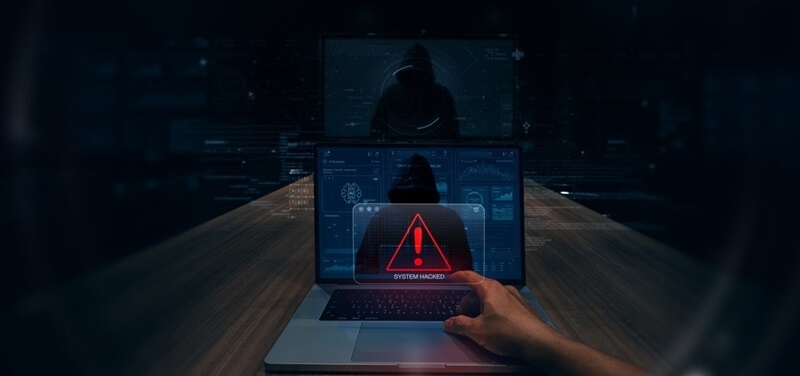
In today's hyperconnected digital world, cyber threats are escalating in severity and magnitude. Companies worldwide, especially in the USA, are adopting cutting-edge smarter technologies, including AI in cybersecurity, at a frantic pace to outwit cybercriminals. Among the most innovative developments is the application of AI for cybersecurity. Artificial Intelligence (AI) and Machine Learning (ML) are no longer science fiction — they are transforming the way security teams predict, detect, and respond to cyber threats in real-time. Read on to learn about threat detection with AI as well as AI-based security software.

Cyber threats have gone far beyond phishing attacks or basic malware. Today, cybercriminals are launching advanced persistent threats (APTs), ransomware, zero-day attacks, and even AI-powered attacks. Traditional security controls like firewalls, antivirus, and manual monitoring systems cannot keep pace. That's where AI-powered security software enters the picture — enabling intelligent, rapid, and scalable defense.
AI-based solutions parse through massive amounts of data in real-time, searching for unusual patterns and alerting on potential threats well before any human is engaged.
Machine learning algorithms are founded on what has happened in the past so that they may predict likely future attacks.
Those days are behind us when cybersecurity teams would respond to breaches in days or hours.
Businesses globally and in the US are adopting cybersecurity AI tools USA authorities recommend for various uses. Some of the greatest benefits are as follows:
AI can process and scan massive volumes of data from network traffic, endpoint computers, and external threat intelligence feeds — in a matter of seconds. AI-powered security software is thus an unbeatable value for businesses that handle colossal digital workloads.
Traditional cybersecurity's greatest challenge is the amount of false alarms generated by rule-based systems. AI cyber security solves the alert fatigue issue by constantly distinguishing between actual threats and benign anomalies, and thus allowing the analysts to prioritize what is most critical.
AI requires no sleep. Cybersecurity AI products US companies are using provide 24/7 security, continuously monitoring for threats and automatically responding without the need for human intervention.
In contrast with static defense mechanisms, AI systems grow stronger over time. With each threat or anomaly encountered, machine learning algorithms are revised, and the defense mechanism becomes stronger and smarter with time. This type of agility is required in a world where cybersecurity threats emerge every day.
AI is already being used by some industry participants and government agencies to improve their cybersecurity. Here's how it works in real life:
Phishing remains the most common attack vector. AI-driven security solutions can analyze the subject, metadata, and sender behavior of incoming mail to detect phishing attacks, even when the emails get through standard spam filters.
Cyberdefense AI can also get traffic examined in real time. If information is being sent at lightning speed, or to foreign IP addresses that were never accessed before, AI solutions can detect and terminate such activities in real time.
Laptops, smartphones, and IoT sensors are typical vulnerable endpoints. With predictive threat analysis, AI can monitor endpoint behavior and quarantine suspicious devices before it can spread malware to the rest of the network.
Banks and other financial institutions utilize cybersecurity AI tools USA developers have developed to monitor spending habits and detect fraud in real time. The systems send alerts on suspect spending, location mismatch, or anomalous transaction volumes.
As more organizations migrate to cloud infrastructure, cloud-native AI security tools are essential. They take care of access control, monitoring cloud traffic, and preventing misconfiguration, one of the major causes of cloud breaches.
Although the payoff is significant, it is not easy to implement AI in cybersecurity:
Data Privacy: AI application requires access to large datasets that could include personal user information. Striking a balance between data privacy and AI utilization is a challenge.
Adversarial AI: Cybercriminals have started creating AI-enabled malware that learns to bypass security measures, mimic user behavior, and conceal itself. This introduces a new aspect to the arms race in cybersecurity.
Dependence and Complacency: Excessive reliance on automated tools makes human analysts less vigilant. Human-in-the-loop is necessary even with automated incident response tools.
High Costs and Skills Gap: Advanced cybersecurity AI solutions that US companies utilize are expensive and need expert-level skills that small-to-medium-sized enterprises lack.
The Future of Cybersecurity with AI
The future of cyber security will be powered by predictive threat analysis, threat hunting in real time, and incident response automation — courtesy of AI and ML. It won't be simply a matter of implementing tools, though; it will be a matter of success depending on:
Integration with legacy infrastructure: AI solutions need to communicate with conventional systems for obstruction-free performance.
Ongoing training and learning: To stay ahead of new threats, AI systems must be constantly updated and retrained with new data.
Transparency and ethics in AI: Security teams must ensure their AI systems are transparent, equitable, and aligned with laws and regulations.
USA government and regulators are stepping in, encouraging the adoption of cybersecurity AI solutions that USA businesses can trust. The National Institute of Standards and Technology (NIST), for instance, is working on guidelines for the secure and effective application of AI in critical infrastructure.
Not every AI tool is created equal. When leveraging AI-based security software, businesses must consider:
Accuracy and detection rates: How effectively is the tool able to detect real threats?
Scalability: Is it able to handle large volumes of data and grow with your expanding organization?
Support and updates: Is the tool backed by a reputable vendor that regularly pushes updates in a timely fashion?
Some of the leading AI cybersecurity solutions that US companies trust include IBM QRadar, Darktrace, CrowdStrike Falcon, and Palo Alto Cortex XDR. They offer advanced predictive threat analysis, best-in-class detection capabilities, and incident response automation capabilities.
Machine learning and AI are not just augmenting cybersecurity; they are transforming how it operates. Instead of relying solely on rule-based systems, organizations are now using intelligent, dynamic, and predictive tools to fight cyber attacks more effectively. Businesses need to step up and learn about these aspects to keep up with the game. AI in cybersecurity is likely to impact the future.
Companies in the USA and around the world are now using AI to stay safe. This is not just a smart choice, but a necessary one. Since hackers never stop, businesses must always be alert. By using AI tools, human experts, and clear rules, companies can stay ahead of cyber threats.
This content was created by AI